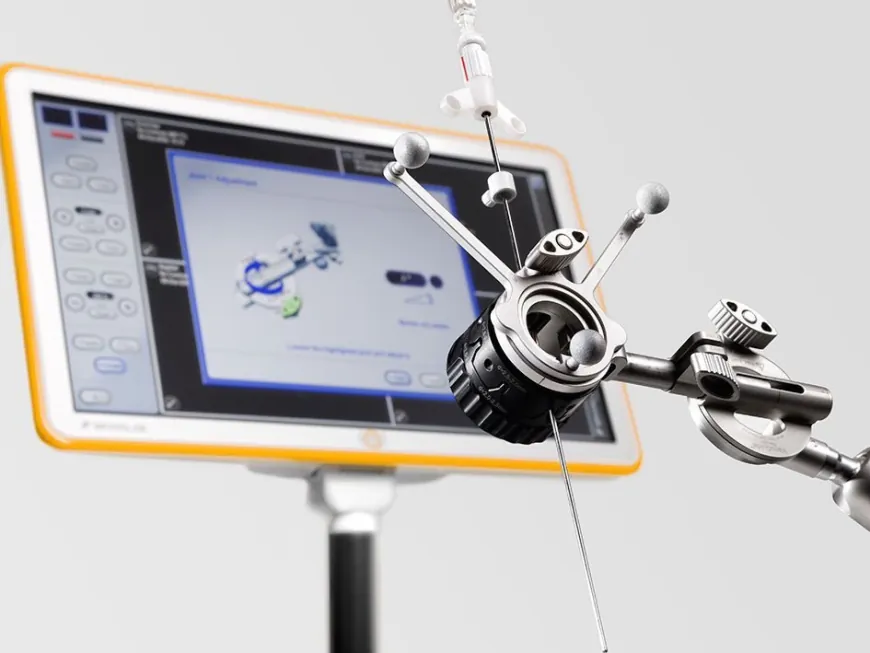Neuro-Navigation Systems: Advanced Technologies Enabling Precise Brain Surgeries
Neuro-navigation systems, also known as image-guided surgery systems, are advanced computer technologies that allow neurosurgeons to precisely locate surgical targets in the brain.

Neuro-navigation systems, also known as image-guided surgery systems, are advanced computer technologies that allow neurosurgeons to precisely locate surgical targets in the brain. These navigation systems work by integrating preoperative MRI or CT scan images with real-time information to guide instruments and minimize invasive procedures. With neuro-navigation, surgeons can identify safe entry points, navigate complex pathways, and confirm the location of lesions or tumors.
Workings
All Neuro-Navigation Systems start with a preoperative brain scan, usually an MRI or CT scan taken before surgery. These scans are uploaded into the navigation system's software and provide a digital map of the patient's brain anatomy and any abnormalities. During surgery, the patient is fitted with Tracking sensors, such as reflective markers that are visible to infrared cameras in the operating room. These sensors identify the exact positions of surgical instruments, the patient's head, and anatomical landmarks.
As the surgeon operates, the navigation system constantly monitors the position and orientation of the tracked tools. It compares this real-time position data to the preoperative scan images. Visualization software then generates an image on the surgeon's computer display showing the integrated scan data with the real positions of instruments and anatomy overlaid on top. This allows surgeons to "see" inside the brain on their display and navigate to targets with precision. Some advanced systems also offer haptic feedback to guide instrument movements.
Applications in Brain Tumor Surgery
One of the most common uses of neuro-navigation is to help locate and resect brain tumors. Being able to accurately identify a tumor's position, size, and proximity to critical structures is essential for safe and effective removal. With navigation, surgeons can plan bypass routes around sensitive areas and directly navigate biopsy instruments or resection tools into the tumor site with greater confidence.
Navigation also helps surgeons monitor the extent of resection. As tissue is removed, the system tracks changes in brain shift and anatomy in real-time. Surgeons can confirm all visible parts of the tumor have been excised before closing. Some advanced navigation platforms integrate fiber-optic fluorescence imaging to visualize tumor margins not seen with the naked eye. This "enhanced visualization" further aids total resection of abnormalities.
Benefits for Deep Brain Stimulation
Deep brain stimulation (DBS) involves precisely implanting thin electrode leads into specific deep brain structures to deliver electrical impulses for controlling neurological and psychiatric conditions like Parkinson's disease, tremors, and chronic pain. Neuro-navigation is considered essential for achieving accurate and safe DBS electrode placement.
With navigation, neurosurgeons can pre-plan and navigate anatomical DBS targets visualized on integrated brain scans. This allows leads to be directly guided into positions just millimeters from critical areas. Studies show navigation significantly improves targeting accuracy versus freehand DBS surgery. Reducing errors enhances therapeutic effects and limits adverse side effects from misplaced implants. Advanced augmented reality systems now overlay interactive 3D models and trajectories to provide real-time DBS planning and guidance.
Advancing Minimally Invasive Surgery
By enabling precise endoscopic instrument targeting through small burr holes or catheter systems, neuro-navigation is also expanding the types of procedures that can be performed minimally invasively. Conditions like arteriovenous malformations, deep-seated aneurysms, and hydrocephalus shunt revisions—once only treatable with open craniotomies—can now be addressed using neuro-navigation assisted endoscopic or catheter-guided approaches.
This minimizes brain exposure and reduces recovery times, hospital stays, costs, and risks of open surgery like hemorrhage. Ongoing research aims to develop intraoperative MRI, ultrasound, and image fusion capabilities that help navigate instruments beyond the skull base and within deep sylvian fissures with enhanced accuracy. Combined with robotics, 5G-assisted telesurgery may one day allow remote neurosurgery with a navigated assistant robot at distant locations.
Advancing the Field Through Innovation
As neuro-navigation systems continue advancing, new imaging modalities are being integrated to provide enriched intraoperative visualization. Examples include augmented fluorescence for visualizing vasculature, MRI-linear accelerator fusion for targeted radiosurgery, integrated 7T MRI for high-resolution scanning, and AI-powered models for planning complex corridor approaches. Wearable and handheld navigation solutions supplemented with haptics, augmented reality overlays, and virtual monitors are improving maneuverability in tight operating suites.
Network-connected navigation also enables sharing preoperative scans and plans between surgical centers for consultations or telementoring. Advances in miniaturized electronics, sensing, robotics, and wireless technologies will allow next-generation systems to provide enhanced mobility, integration of multiple imagers, and even untethered use beyond the skull. As neuro-navigation evolves, it will continue transforming the standards and outcomes of brain and spinal surgeries worldwide.
Get more insights on Neuro-Navigation Systems
Discover the Report for More Insights, Tailored to Your Language
French | German | Italian | Russian | Japanese | Chinese | Korean | Portuguese
About Author:
Ravina Pandya, Content Writer, has a strong foothold in the market research industry. She specializes in writing well-researched articles from different industries, including food and beverages, information and technology, healthcare, chemical and materials, etc. (https://www.linkedin.com/in/ravina-pandya-1a3984191)












